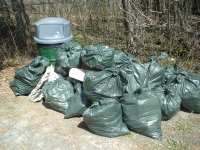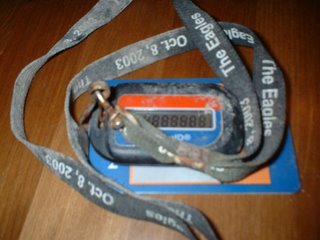 Cleaning up a neighborhood road with family & friends, we took out 22 bags of garbage. We also took out a single RSA SecurID token previously belonging to an employee of a prominent local IT company (likely stolen and then tossed into the woods once the thief realized it wasn't a garage door opener).
Cleaning up a neighborhood road with family & friends, we took out 22 bags of garbage. We also took out a single RSA SecurID token previously belonging to an employee of a prominent local IT company (likely stolen and then tossed into the woods once the thief realized it wasn't a garage door opener).The token has an URL on its back, at which there are instructions for anybody who comes across a token.
Fundamentally, the guidance is 'toss it'. Presumably to convince finders of the environmental sanctity of this course of action, RSA provides a reassuring Token Disposal Statement.
- No hazardous materials are used in the manufacture of the product. The products contain no CFCs or ozone depleting materials, nor were such materials used in their manufacture.
- RSA SecurID tokens are lead free, and use a low voltage 3.3 volt lithium battery. When new, a token has less than .5 grams of lithium. This amount decreases as the token is used. This amount is very small and does not pose any health risk.
- RSA SecurID tokens are also completely emission free, and do not emit radiation or electro-magnetic waves.

Notwithstanding the above assertion, potential emissions would appear to be yet another downside of the 'token necklace' phenomena (I wonder if I should shorten the length of my Token Neck Strap (TNS) to ensure that any such emissions penetrate harmlessly into my upper thorax rather than genetically sensitive alternatives?). Or, might the emissions of multiple tokens cancel each other? Do I need more tokens arranged strategically around my body?
Personally, I think RSA could have done more to encourage recycling.
If found, this SAML assertion makes a nice greeting card when printed out.
1 comment:
From an engineering viewpoint, the RSA statement at http://www.rsa.com/support/pdfs/Token_Disposal_statement.pdf makes me think that I am being deliberately misled. Note the careful choice of words to make users comfortable. The statement swaps calmly between present and past tense to convey an impression that all is well. It certainly may be well with new tokens but it does not address the old ones fully.
For example: "No hazardous materials are used in the manufacture of the product" Good but past versions of the prouct are not addressed by this sentence. The next sentence is much more restrictive. "The products contain no CFCs or ozone depleting materials, nor were such materials used in their manufacture." In other words, other hazardous materials (but not ozone deleting ones) could have been used in the past.
Another example is:
"RSA SecurID tokens are lead free". No mention if old ones were.
Also "a token has less than .5 grams of lithium. This amount decreases as the token is used" seems to imply that lithium escapes from the device during use and is not just converted to another compound of lithium inside. Luckily small amounts of lithium are non-toxic and possibly medicinal :-).
Finally: "RSA SecurID tokens are also completely emission free, and do not emit radiation or electro-magnetic waves". I find that hard to beieve since all electrical devices (including humans) will produce some electromagnetic waves. These are almost certainly perfectly safe but this falls in the category of "never say never"
For a technical company like RSA, this document seems surprisingly lax in its technical rigor.
Post a Comment